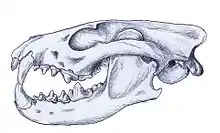| Sunkahetanka Temporal range: | |
|---|---|
 | |
| Sunkahetanka geringensis | |
| Scientific classification | |
| Domain: | Eukaryota |
| Kingdom: | Animalia |
| Phylum: | Chordata |
| Class: | Mammalia |
| Order: | Carnivora |
| Family: | Canidae |
| Subfamily: | †Hesperocyoninae |
| Genus: | †Sunkahetanka Macdonald, 1963 |
| Species: | †S. geringensis |
| Binomial name | |
| †Sunkahetanka geringensis Barbour & Schultz, 1935 | |
Sunkahetanka is an extinct monospecific genus of the Hesperocyoninae subfamily of early canids native to North America. It lived during the Oligocene, 30.8—26.3 Ma, existing for approximately 5 million years.[1] In form, it was intermediate between the small Cynodesmus and the later Enhydrocyon, the first hypercarnivorous, "bone-cracking", canid.[2]
References
- Wang, X. 1994. Phylogenetic systematics of the Hesperocyoninae (Carnivora, Canidae). Bulletin of the American Museum of Natural History, 221:1-207.
This article is issued from Wikipedia. The text is licensed under Creative Commons - Attribution - Sharealike. Additional terms may apply for the media files.